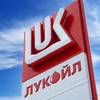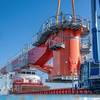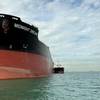Edison Chouest Offshore has new Well Intervention Vessel
By Larry Pearson
Edison Chouest Offshore (ECO) has long been the leading offshore service vessel company in the Gulf of Mexico with more than 100 vessels offering supply, crew transportation, anchor handling and other services. Last year the company debuted the world's largest OSV, the 348-ft. Laney Chouest, an Anchor Handling Tug Supply (AHTS) vessel and the continuation of their 280-ft. series of supply vessels. By the end of this year, six of the 280-ft. vessels will have been built. Now the Galliano, La.-based company is looking to extend its reach internationally and has formed a new company, Island Offshore Shopping AS, to pursue offshore service business internationally. Island Offshore is a joint venture between Edison Chouest Offshore and Ulstein. The first vessel to work for this new company is Island Frontier, a 348 ft. by 78-ft. by 28-ft. Subsea support vessel and a riser-less well intervention vessel. "It is a remarkable vessel for us," said Roger White, senior vice president for ECO. "It is our first vessel rated as DP-3 and can work anywhere in the world, "White said. Built in Norway by the Soviknes Verft AS on a Rolls Royce UT design, this vessel is designed for well intervention and subsea construction. "It would be very expensive for a client to operate this vessel strictly in a supply mode," said White.
The rational for ECO and Ulstein going into this venture at this time is simple. "The number of wells worldwide that this vessel could be called on to service now is 3,300 with another 3,000 in the planning or building stage," White added.
"Initially, the industry thought that the subsea wellheads and other such equipment would last the life of the well, never needing service," White added. "That has proven to be wrong, and up to now it has taken another rig to return to the well to do needed service," White remarked. Now there is a much less expensive alternative, White believes using a vessel such as the Island Frontier. While vessels of this class cannot do all the work capable by a rig, most of the subsea wells needing construction work can be done by the Island Frontier. Among the projects the Island Frontier was built to handle include:
• Subsea installation and module operations.
• ROV Operations
• Well Intervention services
• Diving support
• Trenching
• Offshore pipe laying
• Offshore cable laying
• To transport pipes, equipment and cargo
• To load and unload alongside a pipe laying barge in North Sea Condition
The key feature that makes this vessel able to do well intervention work is a rectangular moon pool located just aft of the engine room. Fitted over the moon pool is a moveable National Oil Well Modular Tower Handling System designed for the safe and efficient handling of subsea intervention tasks. Standing 85 feet tall the tower system has its own 70-ton hydraulic winch and a separate crane.
• The Tower system can be used for the following:
• Handling of the subsea lubricator
• Handling of subsea modules
• Operation of trenchers
• Operation of ROV
In addition to the main winch, the tower has four 5-ton guidewire winches, a cursor winch, a hydraulic maintenance basket, a vertical guiding system and other systems that secures and guides the modules down the tower and through the moon pool. To assist the modules to get from the cargo deck to the spot over the moon pool where they will lowered into the water, a skidding system (twin steel tracks) has been installed to accurately guide these modules to the precise spot where they can lowered through the moon pool. The precise alignment of the ship and the well below is why the vessel was built to DP-3 stipulations. DP-3 regulations are more than another layer of redundancy over a DP-2 system. DP-3 impacts the way is ship is built. For example, there are no open ladders on DP-3 vessels. All ladders must be contained in stair towers. The engine room on a DP-3 vessel is structurally very different than on other types of vessels. The four main propulsion plants are contained in two separate rooms, and so are the two auxiliary generators. In a DP-3 vessel, a catastrophic failure such as the loss if an engine room would not cause the vessel to deviate from its preset course or position. The Island Frontier has two ROV's on board stored on port and starboard sides of the boat in specially equipped hangers. One ROV is designated the Work ROV (starboard) and one is the Observation ROV Port). Their names designate the work they do.
Dominating the aft main deck is an electro-hydraulic Hydralift subsea pedestal crane. The main winch in the crane is a single fall type with a lifting capacity of 100 tons and maximum water depth of 8,535 ft.
There is also an auxiliary winch active heave compensated rated at 10 tons also with an 8,535 ft. maximum water depth. The Islands Frontier also has a mid deck crane and a personnel lift running from the main deck to the heli-deck. The propulsion system is as unique as the rest of the vessel. Main power is from four Ulstein Bergen generator sets, each producing about 2,610 kW of electrical power at 900 rpm. Two Nogva-Cummins KTA-50D(M1) auxiliary generators are installed each with 1,291 kW of electrical power. There is also a Nogva Scandia 360 kW emergency generator on board.
A pair of ABB Azipod electric thrusters propels the vessel with fixed pitched propellers mounted in the "pull" position for greater speed. Power to the thrusters can be varied from 0 to 2,300 kW. In the bow is an Ulstein Aquamaster swing up azimuth thruster rated at 883 kW. There is also a pair of Ulstein Kamawa tunnel thrusters, also rated at 883 kW each. At the stern is an azimuth-type swing up thruster similar to that at the bow for a total of four thrusters and two Azipods. Speed is approximately 14 knots. The Island Frontier also has tankage below, although it is doubtful that it would use its liquid materials strictly for resupply, but rather in conjunction with the well intervention activities. Materials such as glycol, brine, methanol and even liquid mud may be used on well intervention or the labyrinth of pipelines, coiled tubing, flow lines or other elements of the subsea system being worked on. The vessel has accommodations for 84 persons in five four-person cabins, 23 two-person cabins and 18 single cabins. There is even a front deck receptionist on board to handle room key distribution and other services often provided by a hotel. Other people type amenities include separate men and women's locker rooms, coffee shops for smokers and non-smokers, a hospital, a cinema. Two offices and a conference room on the C-deck, two client offices on the B deck, a gymnasium, and a client ROV area with large monitors to watch the work going on underwater. The Island Frontier will fly the Norwegian flag and comply with Norwegian Maritime Directorate's Regulations for Mobile offshore Units. The vessel will also have three Ulstein-type roll reduction tanks. An external communications plant according to GMDSS-4 has been installed and the radar plant included a Furuno ARPA S-Band radar and a Furuno X-Band radars interfaced with the gyros and GPS. There is no question that ECO is thinking internationally and definitely operating "out of the box." Building a worldwide well intervention vessel is light years away from their traditional business of supplying wells and platforms in the Gulf of Mexico. But as we have seen in the last two years, the Gulf of Mexico has its slack production periods in spite of near record gas and oil prices.
Choust thinks they have found a worldwide niche for well intervention services and the Island Frontier may be just the first vessel that Chouest and its joint venture partner Ulstein build to meet this need.












